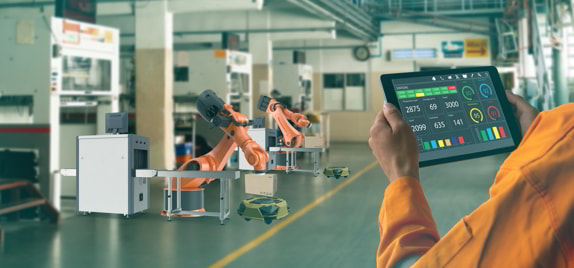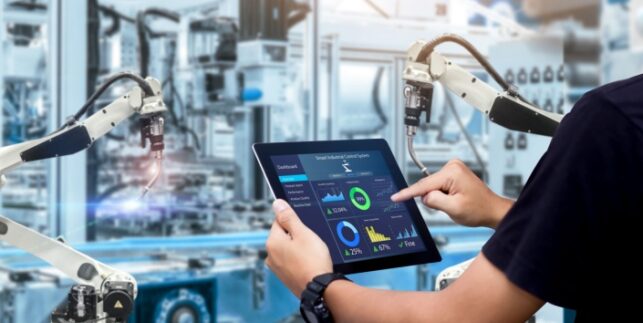Digital Twins and How They’re Changing the Face of Smart Manufacturing

Industry 4.0 is bringing manufacturers many new ways to take advantage of data, using it to better monitor and manage production on the factory floor. One of the most effective ways that manufacturers are undergoing digital transformation is by making use of digital twins.
What Is a Digital Twin?
A digital twin serves as a virtual counterpart to a physical machine on the factory floor. It collects historical and real-time data from the physical twin, providing an accurate model that production teams can use to monitor, evaluate, manage, and control the machine more effectively. Digital twins have multiple purposes from providing enhanced visibility to enabling full simulations of shop-floor processes.
The Unique Advantages of Digital Twins
A digital twin is much more than a simple list of aggregated production data for any given machine. It brings its own unique advantages to the factory floor, adopting the principles of Industry 4.0 in order to improve productivity and efficiency in multiple ways.
Real-time Monitoring
One of the core benefits of the digital twin is that it represents a machine in real-time. Production teams have access to real-time performance and availability information about everything on the factory floor through their digital twins. In turn, this lets them react more quickly to changes as they arise.
With a digital twin, disruptions are identified immediately rather than relying on reports generated at the end of individual shifts or production runs. This lets the production team react right away to solve the issue before it has caused significant losses over an extended period of time.
Comprehensive Overviews
The monitoring provided by digital twins isn’t only notable for being in real-time. It’s also accurate and versatile. With a digital twin, stakeholders are able to evaluate machines based on a broad range of key performance indicators (KPIs), whether in terms of quality, performance, availability, or other factors.
Digital twins also contain historical data from that machine, providing stakeholders with an intuitive way to gauge ongoing performance. They can know right away how current KPIs stack up against optimal or average performance for that individual machine and other machines of the same kind.
Greater Context
The digital twin for any given piece of equipment is by no means isolated. Every machine on the factory floor has a digital twin that is an integral part of a larger solution. Manufacturers will benefit not only from the real-time overviews of individual machines but also from the entire production environment.
With an effective solution tying together the digital twins, manufacturers will be able to better identify and evaluate problems within their complex workflows. From identifying bottlenecks to implementing more effective scheduling, digital twins play an essential role at every level of production.
Seamless Integration
Digital twins are seeing widespread adoption in manufacturing not only due to their clear benefit to productivity but also because of their ease of implementation. While many solutions require significant downtime, digital twins can be implemented without any major disruption to production.
Equipment connectivity and data collection are the two most important areas for solutions that implement digital twins to address. Both of these areas are generally suitable for seamless and non-disruptive integration with existing factory floors, meaning there’s no trade-off in production downtime.
Where Manufacturing Operations Can Benefit From Digital Twins
Digital twins are a major Industry 4.0 technology that is seeing use in a diverse range of industries. Within manufacturing, in particular, they are having an incredible effect on productivity and efficiency. There are multiple areas within any given manufacturing operation that stand to benefit.
Quality Control
Quality control plays an integral part on every factory floor. No matter what a manufacturer is producing, there is some range of acceptable and unacceptable criteria that must be closely monitored. Digital twins make this monitoring more straightforward, allowing for a real-time approach to quality.
Digital twins can keep track of and continuously monitor critical quality KPIs. When these start to shift towards tolerance limits, the digital twin reflects this change immediately. The system can then alert the appropriate stakeholders to take immediate action to correct the quality issue.
Raw Material Consumption
As the highest individual cost in manufacturing, the raw material consumption is an essential area to monitor and optimize. With digital twins, the real-time consumption of bulk raw materials and additives is continuously updated.
Combined with accurate real-time production data, this gives production teams an instantaneous overview of how efficiently raw material is being used. They can identify which machines aren’t in line with their KPIs and address the situation as needed.
Waste Management
A manufacturer’s waste management policy serves as an integral cost-saving mechanism, reducing waste and implementing recycling wherever possible. However, applying the waste management policy to the factory floor presents an additional challenge.
With digital twins, manufacturers are able to continuously monitor actual waste management on the factory floor and compare it with their policy. By setting KPI targets and limits, procedures can be autonomously enforced in real-time on the factory floor with the data provided by the digital twins.
Energy Management
Much like raw material management, energy management plays an important role in reducing production costs. However, energy management is less intuitive and more challenging for manufacturers to implement. The digital twin can greatly simplify the entire process.
Just like any other production data, the digital twin provides both real-time and historical energy consumption data for any individual machine on the factory floor. With this data, manufacturers can better manage their energy use to optimize their costs around demand and peak consumption rates.
Process Optimization
The modern factory floor is often too complex for stakeholders to intuitively optimize workflows. However, the digital twin serves as an effective tool to do so. With clear and accurate production data for every individual machine, manufacturers can better identify areas for improvement.
Digital twins enable stakeholders to evaluate machines based on multiple KPIs and other criteria at once, giving them a fuller understanding of what’s really happening on the factory floor. This, in turn, lets them make informed and accurate decisions when making changes to workflows and processes.
Production Scheduling
Production scheduling has always been a challenging task for manufacturers. Aligning incoming work orders with production capacity is difficult even when everything is working properly and practically impossible when availability and performance issues are considered.
Digital twins make production scheduling easier by providing teams with the information they need to make changes on the fly. Because the digital twins contain comprehensive historical production data, production teams can see how any potential changes will affect the schedule quickly and accurately.
Internal Communications
Production teams need to be able to communicate effectively in order to address problems as they arise. Digital twins can streamline communications by serving as a centralized source of truth for information on individual machines. This gives everyone the necessary context to address issues.
Information silos can be a significant challenge to overcome on the factory floor. Digital twins reduce the amount of time spent tracking down production and maintenance data on specific machines by aggregating it all into a single easy-to-access and intuitive location.

Changing the way people work in factories
Request a DemoTaking Advantage of Digital Twins With Matics
Integrating digital twins into your factory floor could be the best way for your organization to leverage production data and implement Industry 4.0 best practices. Within the framework of a comprehensive solution, they can greatly improve your ability to monitor and manage manufacturing operations.
Matics provides a versatile real-time operational intelligence (RtOI) solution that implements digital twins, along with a wide variety of other visibility, communication, and other features. With a seamless and non-disruptive integration process, your organization can start benefiting from Matics right away
You can contact Matics today to find out more about how our solution can improve productivity and efficiency on your factory floor.




